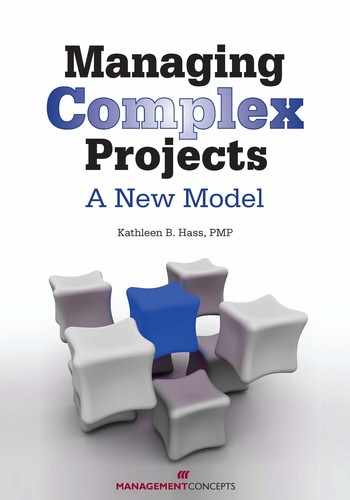PART IV
Managing the Dimensions of Project Complexity
“Traditional management techniques are based on a desire to structure and simplify in order to ‘stabilise’ complex situations. Yet, sometimes, startling and creative solutions can emerge from that very instability. The trick is to know when ‘sticking to the knitting’ will be the most productive approach, and when moving a project to the ‘edge of chaos’ might deliver unexpected performance.”
—HUGH CRAIL, PA CONSULTING
Taking one industry as an example, an examination of initiatives that are underway in financial services organizations around the globe reveals that most of the big firms are actively acquiring smaller companies, while pursuing at least these three interrelated goals:1
 Developing synergies from operations and IT infrastructures to reduce costs across the supply chain
Developing synergies from operations and IT infrastructures to reduce costs across the supply chain Increasing cross-selling of their own and their business partners’ products
Increasing cross-selling of their own and their business partners’ products Enabling customers to do business with the company through whichever channel they find most convenient.
Enabling customers to do business with the company through whichever channel they find most convenient.
These critical changes all need to be developed and implemented concurrently, without disruption to the business—in essence, “while the plane is in the air.” Countless interdependencies among the three initiatives must be understood and managed. Clearly, a new framework for managing multiple complex business initiatives is needed.
In this part we examine the nature of the dimensions of project complexity presented in the Project Complexity Model introduced in Chapter 3 and consider the impacts those complexity dimensions may have on various aspects of a business. We then offer an array of managerial options for your project leadership team to consider.
Complex project management is sensible chaos: the right balance betweens plans (static) and process (dynamic). Some of the managerial options we recommend are conventional project management techniques, and some are definitely on the edge of chaos. We demonstrate how complexity thinking can be applied to manage changes and uncertainties while fostering creativity and innovation. We have included the CHAOS Ten Recipe for Project Success elements identified by the Standish Group as appropriate.
We describe the techniques we recommend for dealing with each dimension of complexity in sufficient detail to enable your project leadership team to consider all aspects and implications of the technique. We focus on the following dimensions of project complexity:
 In Chapter 9 we examine the complexities of large, long-duration projects.
In Chapter 9 we examine the complexities of large, long-duration projects.In Chapter 10 we look at the complexities of large, dispersed, culturally diverse project teams.
 In Chapter 11 we examine the complexities of highly innovative, urgent projects with aggressive scopes and schedules.
In Chapter 11 we examine the complexities of highly innovative, urgent projects with aggressive scopes and schedules. In Chapter 12 we examine the complexities caused by ambiguous business problems, opportunities, and solutions.
In Chapter 12 we examine the complexities caused by ambiguous business problems, opportunities, and solutions. In Chapter 13 we explore the complexities that stem from poorly understood, volatile requirements.
In Chapter 13 we explore the complexities that stem from poorly understood, volatile requirements. In Chapter 14 we look at the complexities involved in highly visible strategic projects, which are often politically sensitive.
In Chapter 14 we look at the complexities involved in highly visible strategic projects, which are often politically sensitive. In Chapter 15 we study the challenges of leading complex, large-scale change initiatives.
In Chapter 15 we study the challenges of leading complex, large-scale change initiatives. In Chapter 16 we examine the risks involved in managing projects with significant dependencies and external constraints.
In Chapter 16 we examine the risks involved in managing projects with significant dependencies and external constraints. In Chapter 17 we explore the challenges of managing projects with a high level of IT complexity.
In Chapter 17 we explore the challenges of managing projects with a high level of IT complexity.
NOTE
1. Hugh Crail, “Putting Complexity Thinking into Practice: Viewpoint on Complexity,” PA Consulting Services Limited (2005). Online at http://www.paconsulting.com/insights/managing_complex_projects/ (accessed February 2008).
